
The Atlantic wolffish, also known as the seawolf, Atlantic catfish, ocean catfish, devil fish, wolf eel, woof or sea cat, is a marine fish of the wolffish family Anarhichadidae, native to the North Atlantic Ocean. The numbers of the Atlantic wolffish in US waters are rapidly being depleted, most likely due to overfishing and bycatch, and it is currently a Species of Concern according to the U.S. National Oceanic and Atmospheric Administration's National Marine Fisheries Service.
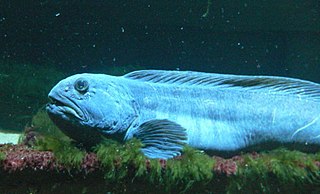
Anarhichadidae, the wolffishes, sea wolves or wolf eels, is a family of marine ray finned fishes belonging to the order Scorpaeniformes. These are predatory, eel shaped fishes which are native to the cold waters of the Arctic, North Pacific and North Atlantic Oceans.
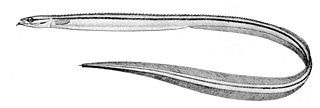
The quillfish,, is a species of marine ray-finned fish, it is the only species in the genus Ptilichthys and family Ptilichthyidae. This fish occurs in the northern North Pacific Ocean.

Bathymaster signatus, the searcher, is species of marine ray-finned fish belonging to the family Bathymasteridae, the ronquils. This species is found in the northern Pacific Ocean.
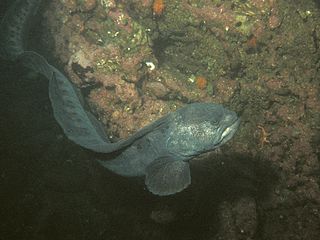
The wolf eel is a species of marine ray-finned fish belonging to the family Anarhichadidae, the wolf fishes. It is found in the North Pacific Ocean. Despite its common name and resemblance, it is not a true eel. It is the only species in the monotypic genus Anarrhichthys.

Anarhichas minor, the spotted wolffish, spotted sea cat or leopardfish, is a large marine fish of the family Anarhichadidae. This bottom-dwelling species is found across the North Atlantic and adjacent parts of the Arctic Ocean from north of Russia and the Scandinavian Peninsula to the Scotian Shelf, off Nova Scotia, Canada. In Canada the population declined by about 90% from the late 1970s through the early 1990s, particularly in the northern part of its range. In Canada it is classified as a threatened species.

Anarhichas is a genus of marine ray-finned fishes belonging to the family Anarhichadidae, the wolffishes or sea wolves. These fishes are found in the northern North Atlantic and North Pacific oceans.

Anarhichas orientalis, the Bering wolffish, is a marine fish in the family Anarhichadidae, the "wolffish".
The dara is a species of marine ray-finned fish, a grunt belonging to the family Haemulidae. It is native to the Atlantic coast of Africa. It is the only species in the monospecific genus Parakuhlia.
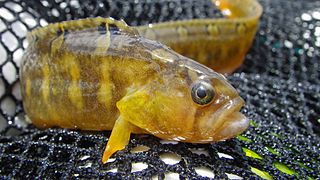
The crescent gunnel, also known as the bracketed blenny, is a species of marine ray-finned fish belonging to the family Pholidae, the gunnels. This fish occurs in the shallow coastal waters of the eastern North Pacific Ocean.
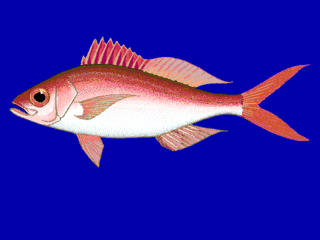
The queen snapper, also known as the night snapper or brim snapper, is a species of ray-finned fish, a snapper belonging to the family Lutjanidae. It is native to the western Atlantic Ocean, and is the only species in the genus Etelis found outside the Indo-Pacific region.
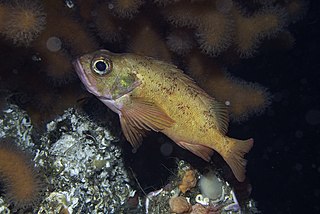
Sebastes viviparus, the Norway redfish, small redfish, lesser redfish, ocean perch or rosefish, is a species of marine ray-finned fish belonging to the subfamily Sebastinae, the rockfishes, part of the family Scorpaenidae. It is found in the northern Atlantic Ocean.

Stichaeinae is a subfamily of marine ray-finned fishes, classified within the family Stichaeidae, the pricklebacks or shannies. These fishes are found in the North Pacific, Arctic and North Atlantic Oceans.

The fourline snakeblenny is a species of marine ray-finned fish belonging to the family Stichaeidae, the pricklebacks and shannies. It is the only species in the monotypic genus Eumesogrammus. This fish is found in the Western North Atlantic, Arctic and North Pacific Oceans.
The radiated shanny is a species of marine ray-finned fish belonging to the family Stichaeidae, the pricklebacks and shannies. It is the only species in the monotypic genus Ulvaria. This fish is found in the northwestern Atlantic Ocean.

Stichaeus is a genus of marine ray-finned fishes belonging to the family Stichaeidae, the pricklebacks or shannies. These fishes are mainly found in the North Pacific Ocean with one species in the Arctic and western North Atlantic Oceans.

The Arctic shanny is a species of marine ray-finned fish belonging to the family Stichaeidae, the pricklebacks and shannies. This species occurs in the North Pacific, Arctic and western North Atlantic Oceans.
Askoldia is a monotypic genus of marine ray-finned fishes belonging to the family Stichaeidae, the pricklebacks and shannies. Its only species is Askoldia variegata which is found in the northwestern Pacific Ocean.
Lumpenopsis is a genus of marine ray-finned fishes belonging to the family Stichaeidae, the pricklebacks or shannies. These fishes are found in the North Pacific Ocean.

The darkblotched rockfish is a species of marine ray-finned fish, a rockfish belonging to the subfamily Sebastinae of the scorpionfish family Scorpaenidae. This is a deepwater species of the North Pacific Ocean.

















